Modelling Method for Aeroelastic Low Engine Order Excitation Originating from Upstream Vanes’ Geometrical Variability
Abstract
1. Introduction
2. Materials and Methods
2.1. Aerofoils Geometrical Variability
2.2. Case Study
2.3. Reduced CFD Domain
2.4. Mistuned Stator Configuration
3. Results
- The number of aerofoils per stage required to represent the physics;
- The number of mistuned aerofoil geometries required in each CFD computation to represent the deviations;
- Methods to reconstruct the forcing spectra starting from multiple MPMR solutions.
3.1. MPMR Forcing Mixture
3.2. MPMR Forcing Superposition
4. Discussion
- The geometrical variability space can be limited to the characterisation of the single aerofoil;
- The CFD domain can be limited to a sector of the geometry of interest, including a single mistuned aerofoil per solution;
- Rotor modal excitation force disturbances can be linearly superimposed to represent the system;
- The full forcing spectrum is reconstructed from the single unit responses, for any arbitrary ordering of the mistuned vanes.
Author Contributions
Funding
Institutional Review Board Statement
Informed Consent Statement
Data Availability Statement
Acknowledgments
Conflicts of Interest
References
- Garzon, V.E.; Darmofal, D.L. Impact of geometric variability on axial compressor performance. J. Turbomach. 2003, 125, 692–703. [Google Scholar] [CrossRef]
- Lange, A.; Vogeler, K.; Gümmer, V.; Schrapp, H.; Clemen, C. Introduction of a Parameter Based Compressor Blade Model for Considering Measured Geometry Uncertainties in Numerical Simulation. In Proceedings of the ASME Turbo Expo, Orlando, FL, USA, 8–12 June 2009; GT2009-59937. pp. 1113–1123. [Google Scholar]
- Lange, A.; Voigt, M.; Vogeler, K.; Schrapp, H.; Johann, E.; Gümmer, V. Impact of manufacturing variability on multistage high-pressure compressor performance. ASME J. Eng. Gas Turbines Power 2012, 134, 112601. [Google Scholar] [CrossRef]
- Lange, A.; Voigt, M.; Vogeler, K.; Schrapp, H.; Johann, E.; Gümmer, V. Impact of Manufacturing Variability and Nonaxisymmetry on High-Pressure Compressor Stage Performance. ASME J. Eng. Gas Turbines Power 2012, 134, 032504. [Google Scholar] [CrossRef]
- Srinivasan, A.V. Flutter and Resonant Vibration Characteristics of Engine Blades: An IGTI Scholar Paper. In Proceedings of the ASME International Gas Turbine and Aeroengine Congress and Exhibition, Orlando, FL, USA, 2–5 June 1997. V004T17A001. [Google Scholar] [CrossRef]
- Crawley, E.F. Aeroelastic Formulation for Tuned and Mistuned Rotors. In AGARD Manual on Aeroelasticity in Axial-Flow Turbomachines; AGARD: Neuilly sur Seine, France, 1988; Volume 2, pp. 1–24. [Google Scholar]
- Castanier, M.P.; Pierre, C. Modeling and analysis of mistuned bladed disk vibration: Current status and emerging directions. J. Propuls. Power 2006, 22, 384–396. [Google Scholar] [CrossRef]
- Slater, J.; Minkiewicz, G.; Blair, A. Forced response of bladed disk assemblies—A survey. In Proceedings of the 34th AIAA/ASME/SAE/ASEE Joint Propulsion Conference and Exhibit, Cleveland, OH, USA, 13–15 July 1999; p. 3743. [Google Scholar]
- Whitehead, D.S. Effect of Mistuning on the Vibration of Turbo-Machine Blades Induced by Wakes. J. Mech. Eng. Sci. 1966, 8, 15–21. [Google Scholar] [CrossRef]
- Martel, C.; Corral, R. Asymptotic Description of Maximum Mistuning Amplification of Bladed Disk Forced Response. ASME J. Eng. Gas Turbines Power 2009, 131, 022506. [Google Scholar] [CrossRef]
- Beirow, B.; Figaschewsky, F.; Kühhorn, A.; Bornhorn, A. Modal Analyses of an Axial Turbine Blisk with Intentional Mistuning. ASME J. Eng. Gas Turbines Power 2018, 140, 012503. [Google Scholar] [CrossRef]
- Maywald, T.; Backhaus, T.; Schrape, S.; Kühhorn, A. Geometric Model Update of Blisks and its Experimental Validation for a Wide Frequency Range. In Proceedings of the ASME Turbo Expo, Charlotte, NC, USA, 26–30 June 2017. V07AT30A001. [Google Scholar]
- Yang, M.; Griffin, J.H. A Normalized Modal Eigenvalue Approach for Resolving Modal Interaction. ASME J. Eng. Gas Turbines Power 1997, 119, 647–650. [Google Scholar] [CrossRef]
- Yang, M.; Griffin, J.H. A Reduced-Order Model of Mistuning Using a Subset of Nominal System Modes. ASME J. Eng. Gas Turbines Power 2001, 123, 893–900. [Google Scholar] [CrossRef]
- Mata, S.; Di Mare, L.; Mehmet, I.; Green, J. Generalised Single-Passage Multi-Bladerow Method for Turbomachinery Forced Response. In Proceedings of the ASME Turbo Expo, Orlando, FL, USA, 8–12 June 2009; pp. 1685–1692. [Google Scholar]
- Stapelfeldt, S.C.; Di Mare, L. A method for modelling flow past non-axisymmetric configurations on reduced passage counts. In Proceedings of the 13th International Symposium on Unsteady Aerodynamics, Aeroacoustics and Aeroelasticity of Turbomachines, Tokyo, Japan, 11–14 September 2012. [Google Scholar]
- Stapelfeldt, S.C. Advanced Methods for Multi-Row Forced Response and Flutter Computations. Ph.D. Thesis, Imperial College London, London, UK, 2013. [Google Scholar]
- Figaschewsky, F.; Giersch, T.; Kühhorn, A. Forced Response Prediction of an Axial Turbine Rotor with Regard to Aerodynamically Mistuned Excitation. In Proceedings of the ASME Turbo Expo, Düsseldorf, Germany, 16–20 June 2014. V07BT35A013. [Google Scholar]
- Gambitta, M.; Kühhorn, A.; Beirow, B.; Schrape, S. Stator Blades Manufacturing Geometrical Variability in Axial Compressors and Impact on the Aeroelastic Excitation Forces. J. Turbomach. 2022, 144, 041007. [Google Scholar] [CrossRef]
- Gambitta, M.; Beirow, B.; Schrape, S. A Digital Twin of Compressor Blisk Manufacturing Geometrical Variability for the Aeroelastic Uncertainty Quantification of the Aerodynamic Damping. In Proceedings of the ASME Turbo Expo, Rotterdam, The Netherlands, 13–17 June 2022. V08AT21A021. [Google Scholar]
- Sayma, A.I.; Vahdati, M.; Sbardella, L.; Imregun, M. Modeling of three-dimensional viscous compressible turbomachinery flows using unstructured hybrid grids. AIAA J. 2000, 38, 945–954. [Google Scholar] [CrossRef]
- Schönweitz, D.; Voges, M.; Goinis, G.; Enders, G.; Johann, E. Experimental and Numerical Examinations of a Transonic Compressor-Stage With Casing Treatment. In Proceedings of the ASME Turbo Expo, San Antonio, TX, USA, 3–7 June 2013. [Google Scholar] [CrossRef]
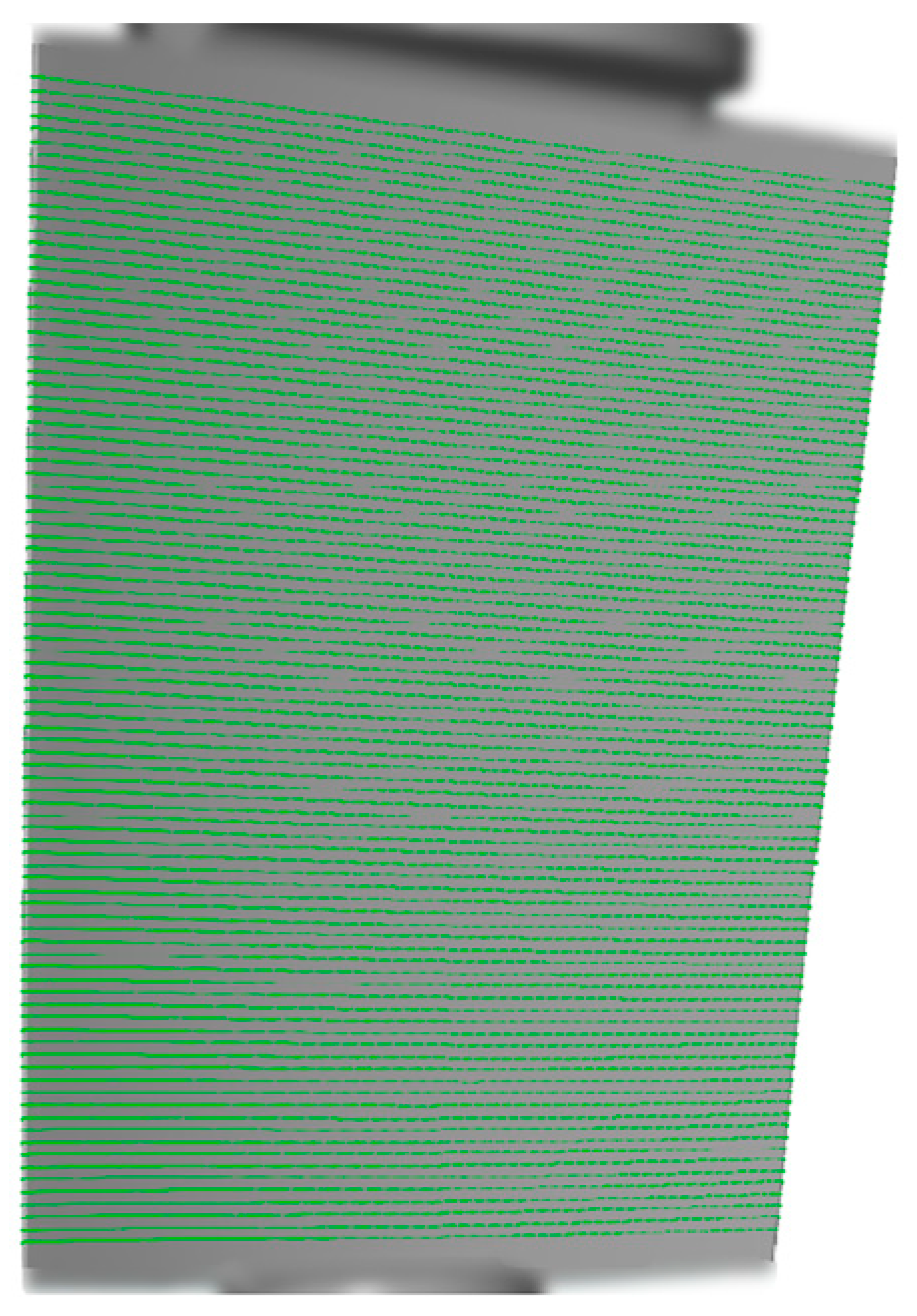
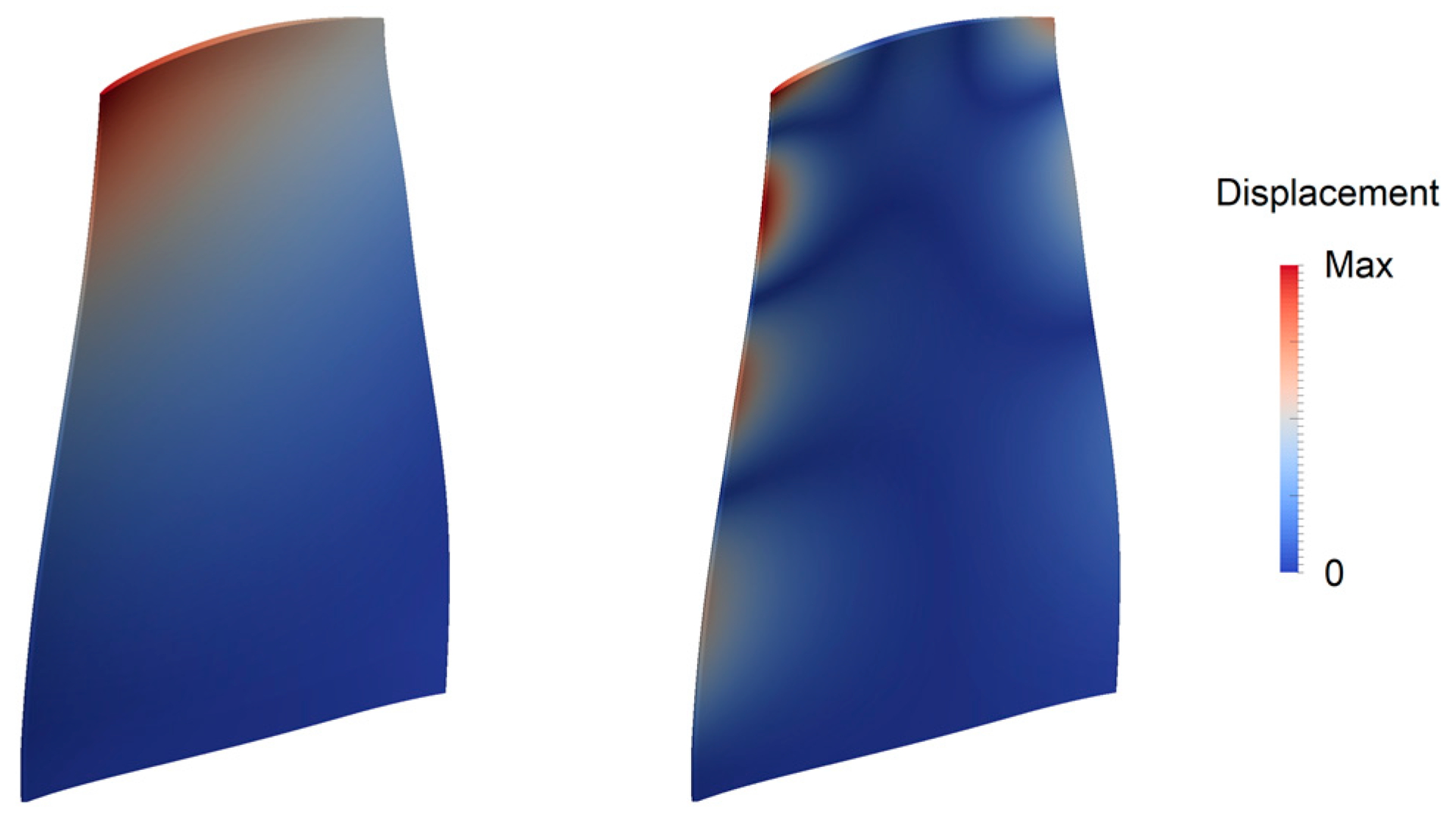



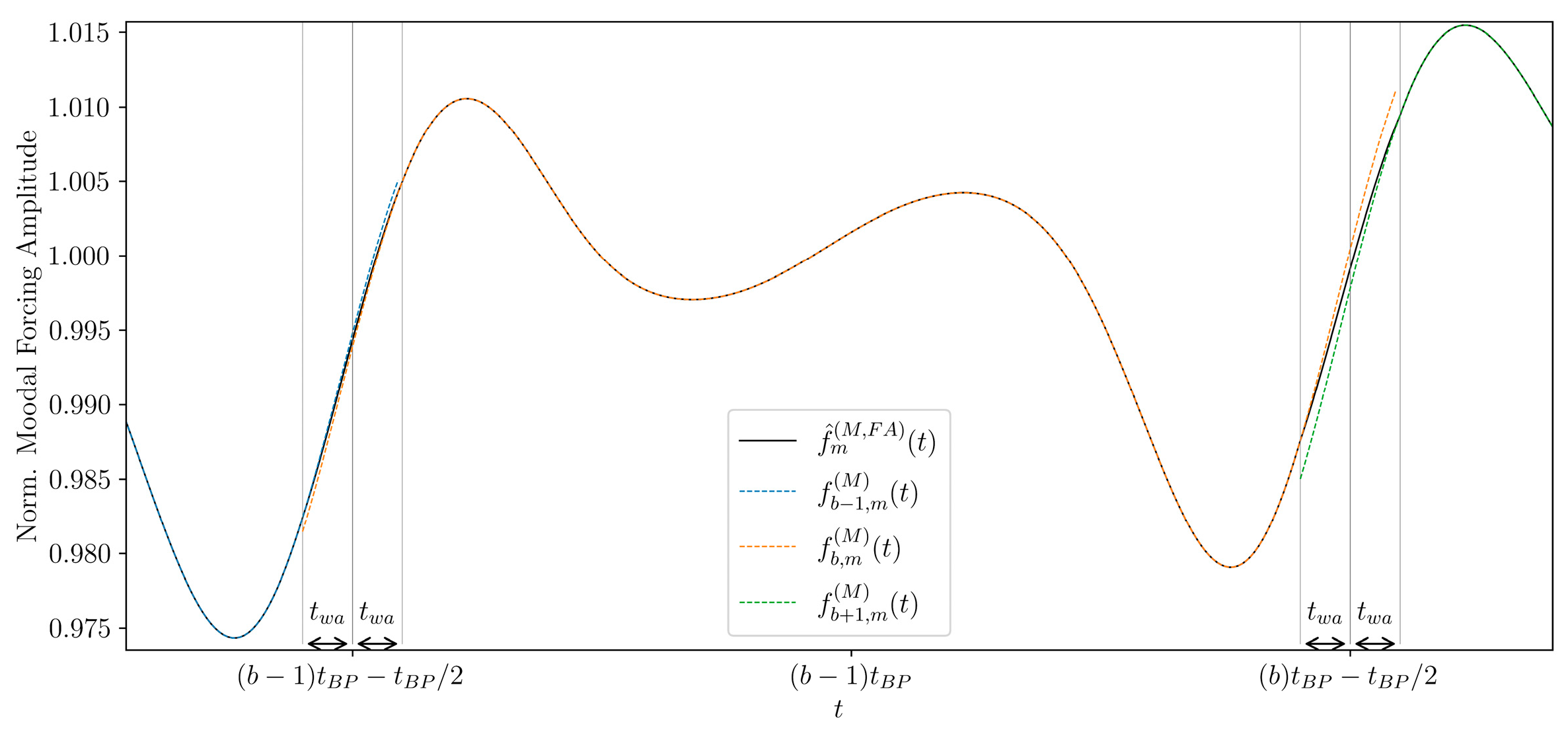
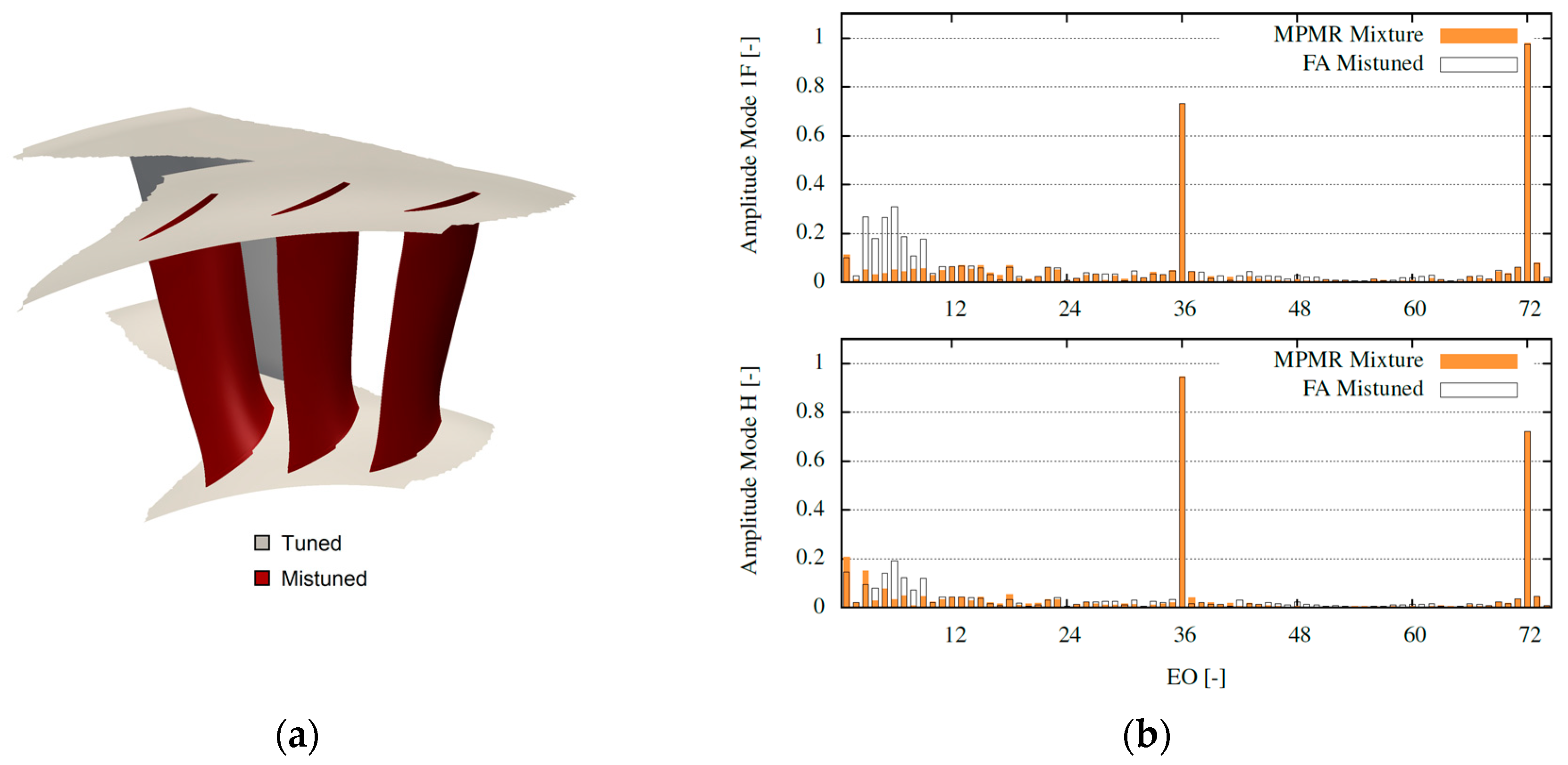
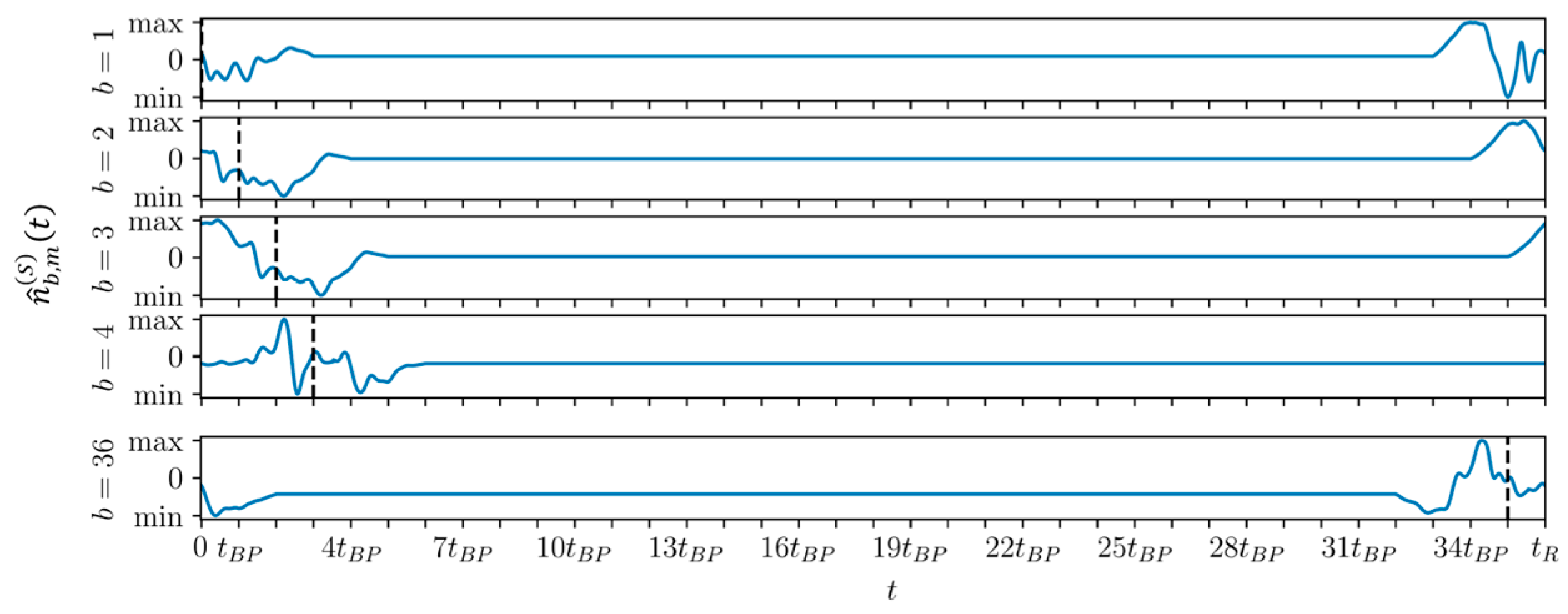
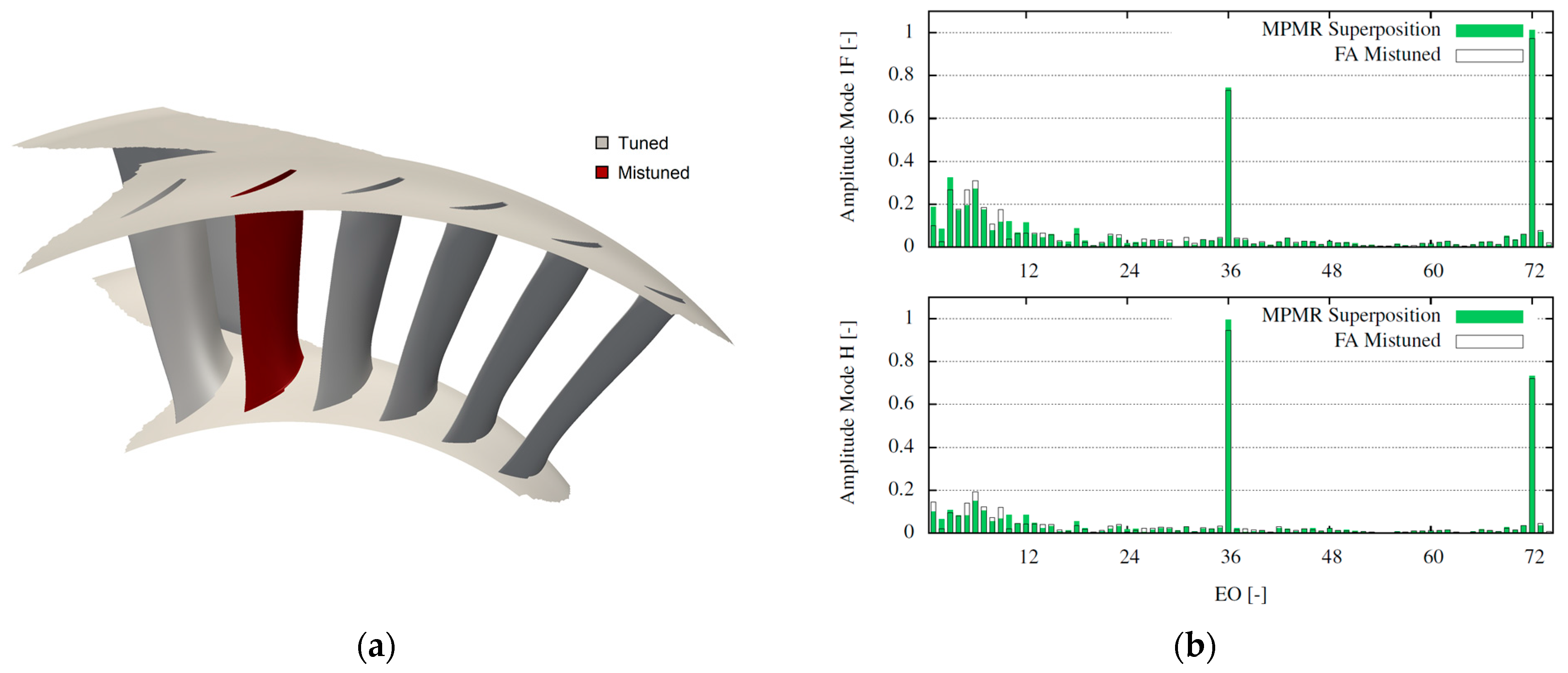
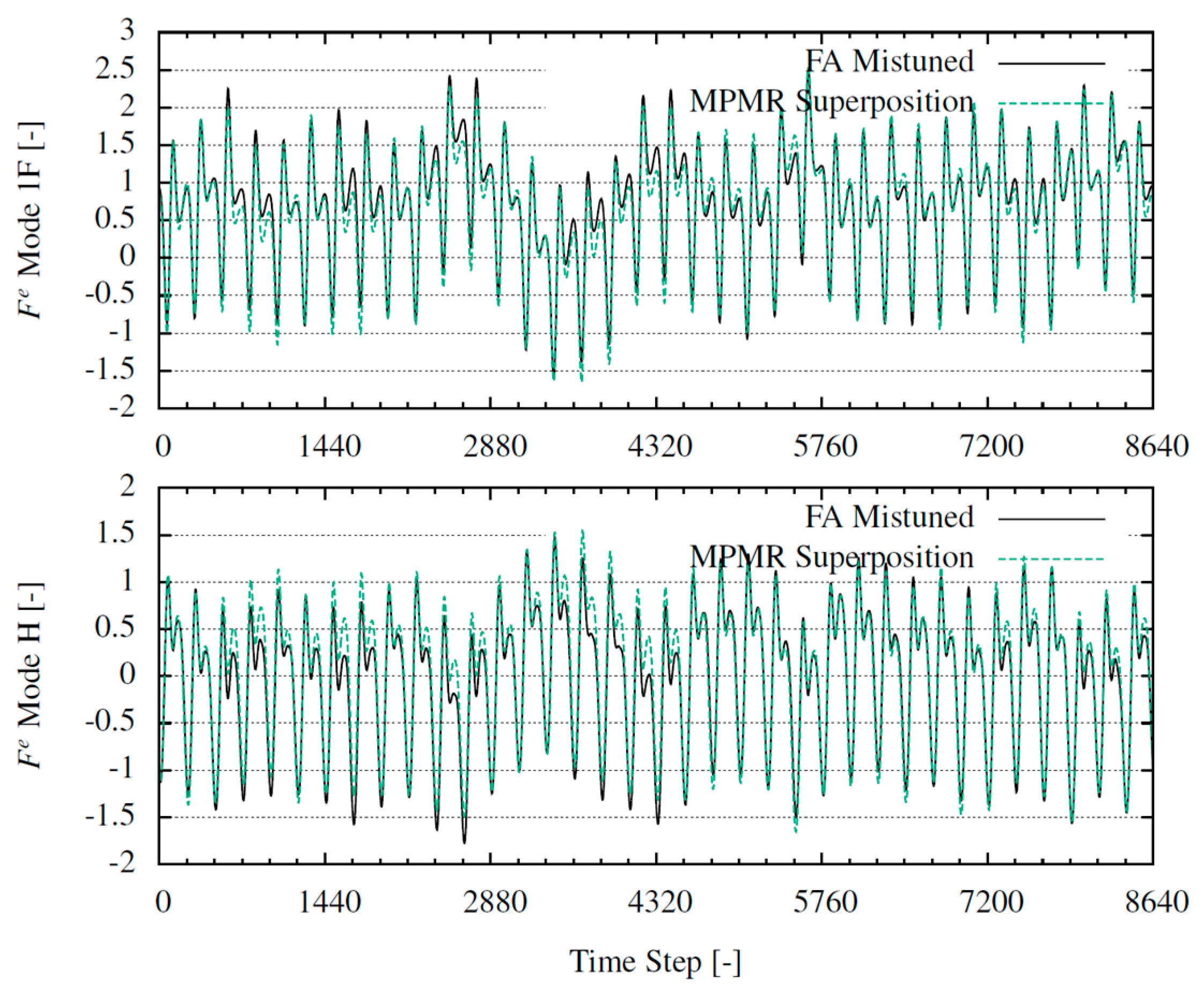

Disclaimer/Publisher’s Note: The statements, opinions and data contained in all publications are solely those of the individual author(s) and contributor(s) and not of MDPI and/or the editor(s). MDPI and/or the editor(s) disclaim responsibility for any injury to people or property resulting from any ideas, methods, instructions or products referred to in the content. |
© 2024 by the authors. Licensee MDPI, Basel, Switzerland. This article is an open access article distributed under the terms and conditions of the Creative Commons Attribution (CC BY-NC-ND) license (https://creativecommons.org/licenses/by-nc-nd/4.0/).
Share and Cite
Gambitta, M.; Beirow, B.; Schrape, S. Modelling Method for Aeroelastic Low Engine Order Excitation Originating from Upstream Vanes’ Geometrical Variability. Int. J. Turbomach. Propuls. Power 2024, 9, 12. https://doi.org/10.3390/ijtpp9020012
Gambitta M, Beirow B, Schrape S. Modelling Method for Aeroelastic Low Engine Order Excitation Originating from Upstream Vanes’ Geometrical Variability. International Journal of Turbomachinery, Propulsion and Power. 2024; 9(2):12. https://doi.org/10.3390/ijtpp9020012
Chicago/Turabian StyleGambitta, Marco, Bernd Beirow, and Sven Schrape. 2024. "Modelling Method for Aeroelastic Low Engine Order Excitation Originating from Upstream Vanes’ Geometrical Variability" International Journal of Turbomachinery, Propulsion and Power 9, no. 2: 12. https://doi.org/10.3390/ijtpp9020012
APA StyleGambitta, M., Beirow, B., & Schrape, S. (2024). Modelling Method for Aeroelastic Low Engine Order Excitation Originating from Upstream Vanes’ Geometrical Variability. International Journal of Turbomachinery, Propulsion and Power, 9(2), 12. https://doi.org/10.3390/ijtpp9020012







